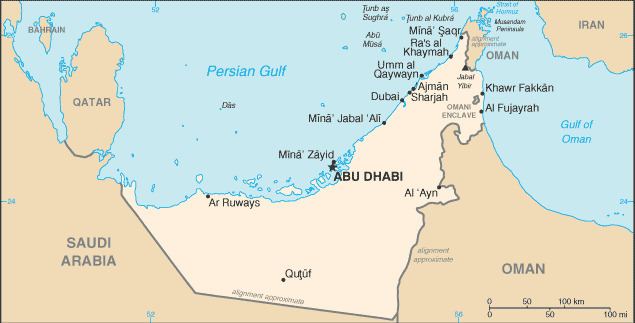 | ||
Energy in the United Arab Emirates describes energy and electricity production, consumption and import in the United Arab Emirates (UAE). UAE has 7% of global proved oil reserves, about 100 billion barrels. Primary energy use in 2009 in UAE was 693 TWh and 151 TWh per million persons.
Contents
The UAE is currently transitioning from an electricity generation system nearly 100% powered by gas power plants (2010) to 100% powered by nuclear, solar and other renewables in order to substantially reduce its carbon emissions. It is also rolling out electric vehicle charging infrastructure.
Oil production
In June 2010 UAE had 6th top global proved oil reserves about 100 billion barrels, behind Saudi Arabia, Venezuela, Iran, Iraq and Kuwait. The crude oil production of UAE was more than 4 and less than 5 million barrels daily.
UAE was 4th top crude oil net exporter (108 Mt in 2008) and 10th top crude oil producers (120 Mt in 2009).
Gas production
UAE has 7th top global proved natural gas reserves, above 6 trillion cubic metres. The global gas production in 2009 was 3 trillion cubic meters.
Solar
The UAE has massive solar generation potential, and its energy policy has shifted substantially due to the declining price of solar. The Dubai Clean Energy Strategy aims to provide 7 per cent of Dubai’s energy from clean energy sources by 2020. It will increase this target to 25 per cent by 2030 and 75 per cent by 2050.
Nuclear
Despite being a large oil exporter, the UAE is installing nuclear power plants to meet its energy needs. It has signed an agreement with the U.S. on nuclear cooperation, and is also a signatory to the nuclear non-proliferation treaty.
Climate change
United Arab Emirates was 6th top carbon dioxide emitter per capita in the world in 2009: 40.31 tonnes per capita. Top countries were (tonnes/capita): Gibraltar 152, U.S. Virgin Islands 114, Qatar 80, Netherlands Antilles 51 and Bahrain 43. All emissions from building and cement production are local but some people may argue that some United Arab Emirates produced fuels and/or goods are consumed abroad. The UAE has begun acting aggressively to reduce its carbon emissions. Dubai Electricity and Water Authority (DEWA) plans a 250 MW pumped-storage hydroelectricity at Hatta using 880 million gallons of water 300 meter above a lower dam.
